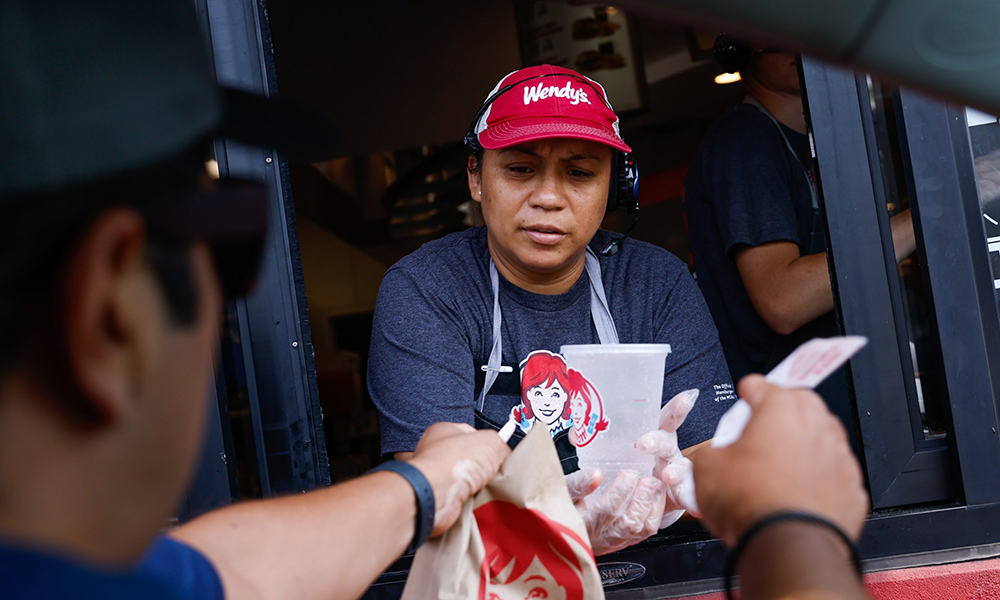
爱马仕和Miu Miu让路吧——最新款小众奢侈品钱包是皱巴巴的纸袋,里面装满了汉堡和油腻的薯条。一份新报告发现,绝大多数美国人如今都觉得快餐过于昂贵,称之为“奢侈品”。
贷款平台LendingTree在上周一发布的一项调查中发现,在2000名美国成年人中,78%的人认为快餐是奢侈品,原因是其价格过于高昂。该调查使用的数据来自QuestionPro(受ValuePenguin委托)。半数受访者表示,捉襟见肘的财务状况让他们觉得快餐是一种奢侈品,超过六成的受访者表示,由于价格上涨,他们减少了快餐的消费。
LendingTree首席信贷分析师马特·舒尔茨(Matt Schulz)通过电子邮件向《财富》杂志表示:“快餐往往不再是快捷、实惠的选择。人们对得来速餐厅的价格感到震惊,这让他们重新考虑吃快餐的频率。”
受访者在4月初参加了这项调查,与此同时,加州针对快餐业工作者的最低时薪法(最低时薪为20美元)开始生效,导致Chipotle等连锁店威胁要将菜单价格提高6%-7%。甚至在最低时薪法颁布之前,消费者就已经对麦当劳(McDonald’s)18美元的巨无霸套餐表示不满,并抨击温蒂汉堡(Wendy’s)在2月推出的“动态定价”,即利用人工智能根据一天中特定时段的客流量改变菜单条目的价格。这家汉堡连锁店在发布消息的第二天就改变了主意,称自己没有涨价计划,只是提供折扣。
事实上,手头拮据的消费者最关心的就是价格激增,72%的受访者表示,如果非营业时间就餐意味着菜品价格便宜,他们会选择在非营业时间就餐。超过一半的受访者表示,如果他们想要吃一顿便宜的快餐,现在会在家做饭。
食品和餐饮顾问、哥伦比亚商学院(Columbia Business School)兼职商学助理教授斯蒂芬·扎戈尔(Stephen Zagor)向《财富》杂志表示,对快餐公司的消极态度是许多人的经济心态的延伸。尽管通胀降温,但快餐价格仍在持续上涨,消费者情绪指数也在下滑:5月,消费者情绪指数降至六个月来的最低点。
扎戈尔说:“我们正处于通胀的心理周期,就像我们所处的通胀现实周期一样。”
“他们倾听消费者的痛苦声音”
扎戈尔说,对于那些因快餐价格状况而感到沮丧的顾客来说,好消息即将到来。汉堡连锁店感受到了做出改变的压力。
他说:“他们倾听消费者的痛苦声音,正在努力做出回应——而且理应如此。”
麦当劳两周前宣布,计划推出5美元套餐,包括汉堡或鸡肉三明治、薯条、四块鸡块和一杯饮料。温蒂汉堡也做出了类似的回应,推出了3美元的早餐套餐,包括早餐土豆,培根或香肠任选其一、鸡蛋和奶酪英式松饼。
这些变化是在快餐连锁店注意到顾客精挑细选导致销售额下滑之后出现的。
麦当劳首席执行官克里斯·坎普钦斯基(Chris Kempczinski)本月在与投资者的电话会议上表示:“消费者在消费时肯定会非常挑剔。这可能在低收入消费者中更为明显,但重要的是要认识到,所有收入群体都在追求价值。”
扎戈尔说,虽然麦当劳只承诺在一个月内提供5美元的套餐优惠——加盟商要求公司投资这项业务——但其他促销活动很可能会持续下去,不过形式可能会有所不同,比如应用程序独享优惠或数字订单的廉价菜单插件。
他认为,快餐公司面临着让顾客满意的压力,即使这最初会给投资者和利润带来更大的提升。作为一个“以关系为基础”的行业,餐饮业仍然需要向食客承诺提供就餐体验回报,即使这只是一次快捷的得来速交易。扎戈尔说,像麦当劳这样的连锁店每天有超过7000万的顾客,是人们生活的基石,他们有义务保持这种状态。
“事实是,我们钟爱麦当劳这个美国品牌。这决定了我们是谁,是好是坏,是恨是爱,是健康还是不健康。这表明了我们是谁。”(财富中文网)
译者:中慧言-王芳
爱马仕和Miu Miu让路吧——最新款小众奢侈品钱包是皱巴巴的纸袋,里面装满了汉堡和油腻的薯条。一份新报告发现,绝大多数美国人如今都觉得快餐过于昂贵,称之为“奢侈品”。
贷款平台LendingTree在上周一发布的一项调查中发现,在2000名美国成年人中,78%的人认为快餐是奢侈品,原因是其价格过于高昂。该调查使用的数据来自QuestionPro(受ValuePenguin委托)。半数受访者表示,捉襟见肘的财务状况让他们觉得快餐是一种奢侈品,超过六成的受访者表示,由于价格上涨,他们减少了快餐的消费。
LendingTree首席信贷分析师马特·舒尔茨(Matt Schulz)通过电子邮件向《财富》杂志表示:“快餐往往不再是快捷、实惠的选择。人们对得来速餐厅的价格感到震惊,这让他们重新考虑吃快餐的频率。”
受访者在4月初参加了这项调查,与此同时,加州针对快餐业工作者的最低时薪法(最低时薪为20美元)开始生效,导致Chipotle等连锁店威胁要将菜单价格提高6%-7%。甚至在最低时薪法颁布之前,消费者就已经对麦当劳(McDonald’s)18美元的巨无霸套餐表示不满,并抨击温蒂汉堡(Wendy’s)在2月推出的“动态定价”,即利用人工智能根据一天中特定时段的客流量改变菜单条目的价格。这家汉堡连锁店在发布消息的第二天就改变了主意,称自己没有涨价计划,只是提供折扣。
事实上,手头拮据的消费者最关心的就是价格激增,72%的受访者表示,如果非营业时间就餐意味着菜品价格便宜,他们会选择在非营业时间就餐。超过一半的受访者表示,如果他们想要吃一顿便宜的快餐,现在会在家做饭。
食品和餐饮顾问、哥伦比亚商学院(Columbia Business School)兼职商学助理教授斯蒂芬·扎戈尔(Stephen Zagor)向《财富》杂志表示,对快餐公司的消极态度是许多人的经济心态的延伸。尽管通胀降温,但快餐价格仍在持续上涨,消费者情绪指数也在下滑:5月,消费者情绪指数降至六个月来的最低点。
扎戈尔说:“我们正处于通胀的心理周期,就像我们所处的通胀现实周期一样。”
“他们倾听消费者的痛苦声音”
扎戈尔说,对于那些因快餐价格状况而感到沮丧的顾客来说,好消息即将到来。汉堡连锁店感受到了做出改变的压力。
他说:“他们倾听消费者的痛苦声音,正在努力做出回应——而且理应如此。”
麦当劳两周前宣布,计划推出5美元套餐,包括汉堡或鸡肉三明治、薯条、四块鸡块和一杯饮料。温蒂汉堡也做出了类似的回应,推出了3美元的早餐套餐,包括早餐土豆,培根或香肠任选其一、鸡蛋和奶酪英式松饼。
这些变化是在快餐连锁店注意到顾客精挑细选导致销售额下滑之后出现的。
麦当劳首席执行官克里斯·坎普钦斯基(Chris Kempczinski)本月在与投资者的电话会议上表示:“消费者在消费时肯定会非常挑剔。这可能在低收入消费者中更为明显,但重要的是要认识到,所有收入群体都在追求价值。”
扎戈尔说,虽然麦当劳只承诺在一个月内提供5美元的套餐优惠——加盟商要求公司投资这项业务——但其他促销活动很可能会持续下去,不过形式可能会有所不同,比如应用程序独享优惠或数字订单的廉价菜单插件。
他认为,快餐公司面临着让顾客满意的压力,即使这最初会给投资者和利润带来更大的提升。作为一个“以关系为基础”的行业,餐饮业仍然需要向食客承诺提供就餐体验回报,即使这只是一次快捷的得来速交易。扎戈尔说,像麦当劳这样的连锁店每天有超过7000万的顾客,是人们生活的基石,他们有义务保持这种状态。
“事实是,我们钟爱麦当劳这个美国品牌。这决定了我们是谁,是好是坏,是恨是爱,是健康还是不健康。这表明了我们是谁。”(财富中文网)
译者:中慧言-王芳
Move over, Hermès and Miu Miu—the newest luxury purse flying under the radar is a crinkled paper bag filled with burgers and greasy fries. The vast majority of Americans now find fast food way too expensive, dubbing it a “luxury,” a new report found.
Of 2,000 American adults, 78% considered fast food a luxury because of its price tag, loan marketplace LendingTree found in a survey released Monday, using data from QuestionPro commissioned by ValuePenguin. Half of respondents said their own stretched financial situation made fast food feel like a luxury, and more than six in 10 said they had cut down on fast food because of rising prices.
“Fast food often isn’t this quick, cheap option anymore,” LendingTree chief credit analyst Matt Schulz told Fortune over email. “People are having sticker shock at the drive-thru, causing them to rethink how often they eat fast food.”
Respondents participated in the survey in early April—the same time California’s $20 minimum wage law for fast-food workers went into effect, causing chains like Chipotle to threaten 6%–7% increases in menu price. Even before the minimum wage law was enacted, consumers revolted against McDonald’s $18 Big Mac meal and blasted Wendy’s for its introduction of “dynamic pricing” in February, using AI to change menu item costs depending on the level of traffic during certain times of day. The burger chain backtracked the day after the announcement, saying it had no plans to raise prices, only provide discounts.
Indeed, pinched consumers are most concerned about surge pricing, with 72% of those surveyed saying they would dine during off-hours if it meant cheaper menu items. Over half of respondents said they now cook at home if they’re looking for a quick, cheap meal.
Stephen Zagor, food and restaurant consultant and adjunct assistant professor of business at the Columbia Business School, told Fortune that bad attitudes toward fast-food companies are an extension of the mentality so many have about the economy. As fast-food prices continue to rise even as inflation cools, consumer sentiment is dipping: In May, it reached its lowest point in six months.
“We’re in this inflationary mental cycle as much as we are an inflationary reality cycle,” Zagor said.
‘They hear the customers’ pain’
But there’s good news on the horizon for customers feeling dejected by the state of fast-food prices, Zagor said. Burger chains are feeling pressure to make changes.
“They hear the customers’ pain, and they’re trying to be responsive—as they well should be,” he said.
McDonald’s announced last week its plans to launch a $5 meal deal of a burger or chicken sandwich, fries, a four-piece nugget, and a drink. Wendy’s responded similarly, rolling out a $3 breakfast deal with breakfast potatoes and a choice of bacon or sausage, egg, and cheese English muffin.
The changes came after fast-food chains noticed sales dips driven by choosy customers.
“The consumer is certainly being very discriminating in how they spend their dollar,” McDonald’s CEO Chris Kempczinski said during a call with investors this month. “It may be more pronounced with lower-income consumers, but it’s important to recognize that all income cohorts are seeking value.”
While McDonald’s is only promising its $5 meal deal for a month—with franchisees asking the company to invest in the operation—additional promotions are likely to stick around, though likely in different forms, such as app-exclusive deals or cheap menu add-ons for digital orders, Zagor said.
Fast-food companies are under pressure to keep their customers happy, even if it is initially a bigger lift for investors and the bottom line, he argued. A “relationship-based” business, the restaurant industry still has to promise its diners a return on the dining experience, even if it’s just a quick drive-thru transaction. With over 70 million customers daily, chains like McDonald’s are a cornerstone of people’s lives, Zagor said, and they are under obligation to stay that way.
“The truth of the matter is, we love McDonald’s. It’s an American brand. It’s who we are—good or bad, hate it or love it, think it’s healthy or unhealthy. It’s who we are.”






